There is a lot of water in Russia – rivers flow across its vast territory, which occupies one seventh of the land area. more than two and a half million rivers. Most of them are known and loved only by those who live (or vacation) on their banks. However, more interesting and important are rivers of a completely different order - giant waterways that can be seen from space. For centuries, these giants served our ancestors as sources of water, food, as transport routes, and continue to serve people to this day.
Determining the longest river in Russia is not so easy. Historically, the lands east of the Urals were populated unevenly in different periods of time. And therefore, along its course, the river could change its name more than once. Sometimes it happened that the supposed tributary of the "main" river turned out to be longer and more full-flowing than the river itself. Therefore, to avoid confusion, for the rating of the longest rivers in Russia, we selected only those that flow under the same name from source to mouth.
10. Ural – length 2428 km
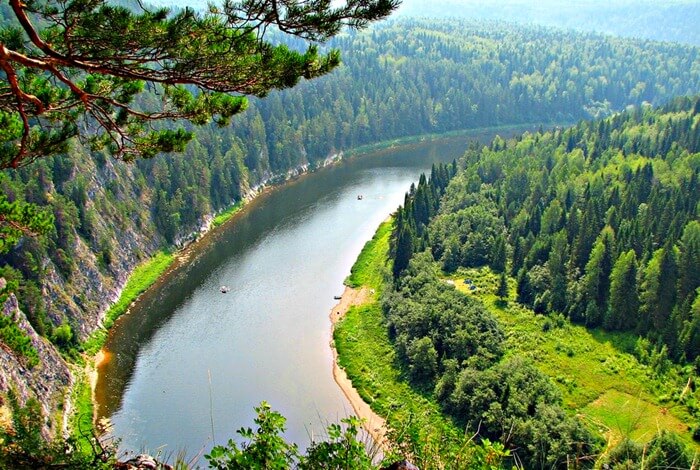 The majestic Siberian Ural opens the rating of the longest rivers in Russia without tributaries. Although it occupies a modest tenth place, if you look only at Europe, it is second only to the Volga and the Danube in length. Once upon a time, the Cossacks who began to develop the expanses of the Trans-Urals called it Yaik. And to this day, under its old name, it appears in numerous Cossack songs.
The majestic Siberian Ural opens the rating of the longest rivers in Russia without tributaries. Although it occupies a modest tenth place, if you look only at Europe, it is second only to the Volga and the Danube in length. Once upon a time, the Cossacks who began to develop the expanses of the Trans-Urals called it Yaik. And to this day, under its old name, it appears in numerous Cossack songs.
The Ural is a capricious river; over the centuries it has repeatedly changed its course, leaving in its basin an abundance of scattered oxbow lakes, lakes and a dense network of channels. The Ural, like the Volga, flows into the Caspian Sea.
9. Ishim – 2450 km
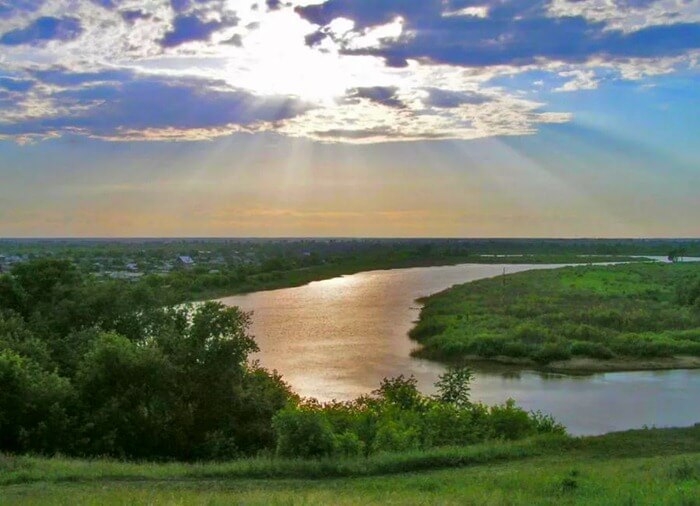 Ishim is more important for its neighbors. In Russia, there is only one city, Ishim, on the banks of this river. While in neighboring Kazakhstan there are several, including even the capital of this country. True, you have to pay for popularity - according to the latest data from environmentalists, it is better not to swim in the Ishim. The river waters carry, in addition to ordinary household waste, also industrial waste - oil products, iron compounds, oil and manganese. And all this wealth is also seasoned with pesticides washed into the river every year during the flood. Ishim flows into the Irtysh.
Ishim is more important for its neighbors. In Russia, there is only one city, Ishim, on the banks of this river. While in neighboring Kazakhstan there are several, including even the capital of this country. True, you have to pay for popularity - according to the latest data from environmentalists, it is better not to swim in the Ishim. The river waters carry, in addition to ordinary household waste, also industrial waste - oil products, iron compounds, oil and manganese. And all this wealth is also seasoned with pesticides washed into the river every year during the flood. Ishim flows into the Irtysh.
8. Vilyuy – 2650 km
 Vilyuy is the longest tributary of the Lena, which is not a small river in itself. It flows through the territory of Yakutia and Krasnoyarsk Krai. There are two hydroelectric power stations on the river, launched back in Soviet times. They provide light, heat and energy to nearby mining facilities.
Vilyuy is the longest tributary of the Lena, which is not a small river in itself. It flows through the territory of Yakutia and Krasnoyarsk Krai. There are two hydroelectric power stations on the river, launched back in Soviet times. They provide light, heat and energy to nearby mining facilities.
One of the tributaries of the Vilyuy is a place of pilgrimage for ufologists, affectionately nicknamed by old-timers "Death Valley". According to rumors, there are huge mysterious objects there, similar to cauldrons, from six to nine meters in diameter, and made of an unknown metal.
7. Amur – 2824 km
 "Clouds move sullenly over the Amur," goes an old Soviet song. It is on this river, separating the lands of the then USSR, and today's Russia, from China, that three tankmen, the heroes of the song, serve.
"Clouds move sullenly over the Amur," goes an old Soviet song. It is on this river, separating the lands of the then USSR, and today's Russia, from China, that three tankmen, the heroes of the song, serve.
The name of the river itself speaks of its size – “Amur” comes from the word “damur”, which literally means “big river” in the language of the locals, the Manchus. It begins in the steppes of Mongolia and flows into the Sea of Okhotsk. The Amur is exceptionally rich in fish – up to 139 different species of fish live in it. But only one quarter of this abundance has commercial value.
6. Lower Tunguska – 2989 km
 The Lower Tunguska is almost as long as the river it flows into – the Yenisei. Although the river is full-flowing in the summer months (the water flow reaches 31 thousand m3/s), in winter it barely collects a quarter of this amount. The reason is permafrost; the underground springs, bound by the cold, barely support the life of the river. But during the melting of snow, the Tunguska crushes rocks and uproots trees.
The Lower Tunguska is almost as long as the river it flows into – the Yenisei. Although the river is full-flowing in the summer months (the water flow reaches 31 thousand m3/s), in winter it barely collects a quarter of this amount. The reason is permafrost; the underground springs, bound by the cold, barely support the life of the river. But during the melting of snow, the Tunguska crushes rocks and uproots trees.
5. Yenisei – 3487 km
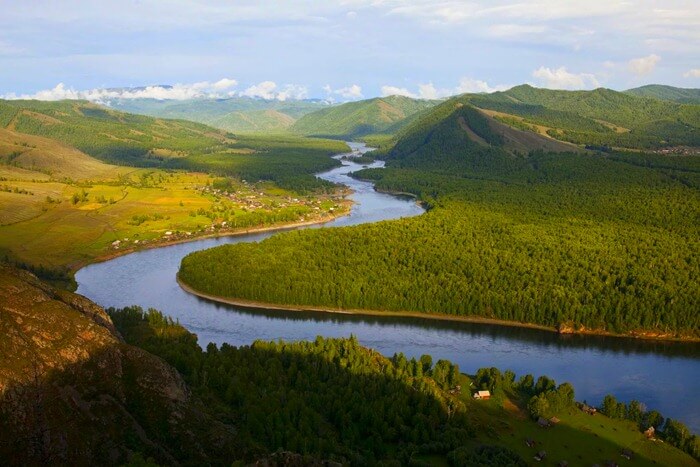 From the tributary of the Yenisei we move to the Yenisei itself. The river separates Eastern Siberia from Western Siberia. The beginning of the Yenisei, the place where two tributaries merge, is located near the city of Kyzyl, the capital of Tuva. And it flows several thousand kilometers to the north, into the Kara Sea, forming an entire bay named after it.
From the tributary of the Yenisei we move to the Yenisei itself. The river separates Eastern Siberia from Western Siberia. The beginning of the Yenisei, the place where two tributaries merge, is located near the city of Kyzyl, the capital of Tuva. And it flows several thousand kilometers to the north, into the Kara Sea, forming an entire bay named after it.
Along the Yenisei River there are many cities, several hydroelectric power stations and a number of reservoirs. Also on the banks of the Yenisei are several of Russia's most beautiful reserves - such as the Krasnoyarsk "Stolby" and the Sayano-Shushensky Nature Reserve.
4. Volga – 3531 km
 The longest river in Europe is undoubtedly worthy of the title of "mother". Since ancient times, Slavs and peoples who would later become part of Russia have settled on its banks. The Volga was first mentioned in his "Notes" by the ancient geographer Herodotus. In the Middle Ages and the New Age, it served as a trade route connecting the north of the country with the south, and during the years of industrialization after the establishment of Soviet power, hydroelectric power stations on the Volga provided industrial enterprises of the young state with electricity.
The longest river in Europe is undoubtedly worthy of the title of "mother". Since ancient times, Slavs and peoples who would later become part of Russia have settled on its banks. The Volga was first mentioned in his "Notes" by the ancient geographer Herodotus. In the Middle Ages and the New Age, it served as a trade route connecting the north of the country with the south, and during the years of industrialization after the establishment of Soviet power, hydroelectric power stations on the Volga provided industrial enterprises of the young state with electricity.
The Volga begins with a modest, unremarkable spring flowing from the Valdai Hills and ends in a delta more than 170 km wide.
3. Ob – 3650 km
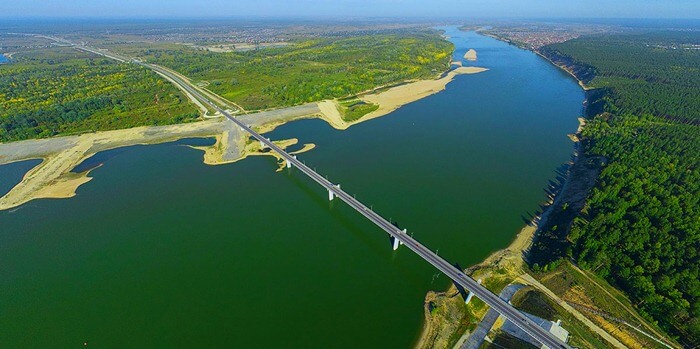 The third longest river in Russia is the Ob. It would be the first if you count it together with its longest tributary, the Irtysh. Then its length would be an impressive 5410 km. The Ob basin is the largest in Russia – its total area is 2990 thousand km2.
The third longest river in Russia is the Ob. It would be the first if you count it together with its longest tributary, the Irtysh. Then its length would be an impressive 5410 km. The Ob basin is the largest in Russia – its total area is 2990 thousand km2.
Despite its size and full flow (during the flood period the Ob can spill up to 30 km in width), the Ob spends most of the year under ice. There are many cities along the river, including such large ones as Novosibirsk. The Ob flows into the bay named after itself in the Kara Sea.
2. Irtysh – 4248 km
 If the development of Siberia had gone a different way, the Irtysh would have been in first place in the rating. But it happened as it happened, and the much longer Irtysh is considered only a tributary of the Ob, and together they occupy 6th place in the list of the longest rivers in the world.
If the development of Siberia had gone a different way, the Irtysh would have been in first place in the rating. But it happened as it happened, and the much longer Irtysh is considered only a tributary of the Ob, and together they occupy 6th place in the list of the longest rivers in the world.
The Irtysh originates in China, where the Chinese take almost a third of the flow for their own needs, then flows through Kazakhstan, where the river is already large enough for ships to navigate along it.
The Irtysh feeds both industrial and agricultural enterprises in Kazakhstan, and supplies water to the country's capital, Astana. The river doesn't have time to rest in Russia either - there are many cities and several power plants on it.
1. The longest river in Russia is Lena (4400 km)
 In the Yakut language, the name of Lena sounds like “big river" The longest river in Russia stretches 4400 km from the Baikal ridges to the Arctic Ocean and flows into the Laptev Sea. It flows in harsh conditions - the surrounding lands are bound by permafrost. Therefore, there are few cities on the Lena, and the largest of them is Yakutsk.
In the Yakut language, the name of Lena sounds like “big river" The longest river in Russia stretches 4400 km from the Baikal ridges to the Arctic Ocean and flows into the Laptev Sea. It flows in harsh conditions - the surrounding lands are bound by permafrost. Therefore, there are few cities on the Lena, and the largest of them is Yakutsk.

For many hundreds of kilometers, the river flows through virtually uninhabited terrain. Like other rivers in permafrost conditions, the Lena is “fed” almost entirely by melted snow and rain, so the water level in it is low in winter. Lena spends most of the year under a thick layer of ice, freeing itself from it only for short 4-5 warm months. Although the navigation period is short, cargo is floated down the Lena, cruises take place, people go boating, go on river hikes and visit attractions. One of the most famous is the Shishkin Rocks, where the creativity of ancient people has survived to this day.
List of the largest rivers in Russia
The table shows 75 rivers with a length of at least 1000 km.
| No. | Name | Length, km | In Russia, km | Flows into |
|---|---|---|---|---|
| 1 | Yenisei – Angara – Baikal – Selenga – Ider | 5550 | 4460 | Yenisei Gulf, Kara Sea |
| 2 | Ob – Irtysh | 5410 | 3050 | Gulf of Ob, Kara Sea |
| 3 | Amur – Argun – Kerulen | 5052 | 4133 | Amur estuary, Sea of Okhotsk |
| 4 | Lena - Vitim - Vitimkan | 4692 | 4692 | Laptev Sea |
| 5 | Ob - Chulym - Bely Iyus | 4565 | 4565 | Gulf of Ob, Kara Sea |
| 6 | Amur – Argun – Hailar | 4444 | 4133 | Amur estuary, Sea of Okhotsk |
| 7 | Lena | 4400 | 4400 | Laptev Sea |
| 8 | Ob - Katun | 4338 | 4338 | Gulf of Ob, Kara Sea |
| 9 | Yenisei – Small Yenisei (Kaa-Khem) | 4287 | 3930 | Yenisei Gulf, Kara Sea |
| 10 | Amur - Shilka - Onon | 4279 | 3981 | Amur estuary, Sea of Okhotsk |
| 11 | Irtysh | 4248 | 1900 | r. Ob |
| 12 | Yenisei - Big Yenisei (Biy-Khem) | 4123 | 4123 | Yenisei Gulf, Kara Sea |
| 13 | Volga - Oka | 3731 | 3731 | Caspian Sea |
| 14 | Ob River proper | 3650 | 3650 | Gulf of Ob, Kara Sea |
| 15 | Volga - Kama | 3560 | 3560 | Caspian Sea |
| 16 | Volga | 3531 | 3531 | Caspian Sea |
| 17 | Yenisei proper | 3487 | 3487 | Yenisei Gulf, Kara Sea |
| 18 | Lower Tunguska | 2989 | 2989 | Yenisei river |
| 19 | Cupid proper | 2824 | 2824 | Amur estuary, Sea of Okhotsk |
| 20 | Vilyuy | 2650 | 2650 | r. Lena |
| 21 | Kolyma - Kulu | 2513 | 2513 | East Siberian Sea |
| 22 | Ishim | 2450 | 800 | Irtysh river |
| 23 | Ural | 2422 | 1550 | Caspian Sea |
| 24 | Little deer | 2292 | 2292 | Olenek Bay, Laptev Sea |
| 25 | Aldan | 2273 | 2273 | r. Lena |
| 26 | Dnieper | 2201 | 485 | Black Sea |
| 27 | Kolyma | 2129 | 2129 | East Siberian Sea |
| 28 | Vitim – Vitimkan | 1978 | 1978 | r. Lena |
| 29 | Indigirka – Khastakh | 1977 | 1977 | East Siberian Sea |
| 30 | Don - Voronezh - Polnoy Voronezh | 1923 | 1923 | Taganrog Bay, Sea of Azov |
| 31 | Don | 1870 | 1870 | Taganrog Bay, Sea of Azov |
| 32 | Podkamennaya Tunguska | 1865 | 1865 | Yenisei river |
| 33 | Vitim | 1837 | 1837 | r. Lena |
| 34 | Pechora | 1809 | 1809 | Pechora Bay, Pechora Sea, Barents Sea |
| 35 | Kama | 1805 | 1805 | Volga river |
| 36 | Northern Dvina - Vychegda | 1803 | 1803 | Dvina Bay, White Sea |
| 37 | Chulym | 1799 | 1799 | r. Ob |
| 38 | Angara | 1779 | 1779 | Yenisei river |
| 39 | Indigirka | 1726 | 1726 | East Siberian Sea |
| 40 | Northern Dvina – Sukhona – Kubenskoye Lake – Kubena | 1683 | 1683 | Dvina Bay, White Sea |
| 41 | Khatanga - Kotuy | 1636 | 1636 | Khatanga Gulf, Laptev Sea |
| 42 | Ket | 1621 | 1621 | r. Ob |
| 43 | Argun - Hailar | 1620 | 1487 | Amur river |
| 44 | Tobol | 1591 | 1090 | Irtysh river |
| 45 | Alazeya | 1590 | 1590 | East Siberian Sea |
| 46 | Oka | 1500 | 1500 | Volga river |
| 47 | Yana - Sartang | 1492 | 1492 | Laptev Sea |
| 48 | Amga | 1462 | 1462 | r. Lena |
| 49 | Olekma | 1436 | 1436 | r. Lena |
| 50 | Selenga - Ider | 1433 | 409 | Lake Baikal |
| 51 | White | 1430 | 1430 | Nizhnekamsk reservoir, Kama |
| 52 | Pelvis | 1401 | 1401 | Tazovskaya Bay, Kara Sea |
| 53 | Tavda - Lozva | 1356 | 1356 | Tobol river |
| 54 | Northern Dvina - South | 1318 | 1318 | Dvina Bay, White Sea |
| 55 | Vyatka | 1314 | 1314 | river Kama |
| 56 | Zeya | 1242 | 1242 | Amur river |
| 57 | Taseeva – Uda (Chuna) | 1240 | 1240 | r. Angara |
| 58 | Uda (Chuna) | 1203 | 1203 | R. Taseeva |
| 59 | Marha | 1181 | 1181 | r. Vilyuy |
| 60 | Demyanka | 1160 | 1160 | Irtysh river |
| 61 | Omolon | 1150 | 1150 | Kolyma river |
| 62 | Anadyr | 1150 | 1150 | Anadyr Bay, Bering Sea |
| 63 | Vychegda | 1130 | 1130 | Northern Dvina river |
| 64 | Gum | 1130 | 555 | Dnieper river |
| 65 | Konda | 1097 | 1097 | Irtysh river |
| 66 | Om | 1091 | 1091 | Irtysh river |
| 67 | Vasyugan | 1082 | 1082 | r. Ob |
| 68 | Maya | 1053 | 1053 | r. Aldan |
| 69 | Seversky Donets | 1053 | 335 | r. Don |
| 70 | Onon | 1032 | 734 | r. Shilka |
| 71 | Tour | 1030 | 1030 | Tobol river |
| 72 | Pur - Pyakupur | 1024 | 1024 | Tazovskaya Bay, Kara Sea |
| 73 | Western Dvina (Daugava) | 1020 | 325 | Gulf of Riga, Baltic Sea |
| 74 | Biryusa (She) | 1012 | 1012 | R. Taseeva |
| 75 | Hopper | 1010 | 1010 | r. Don |

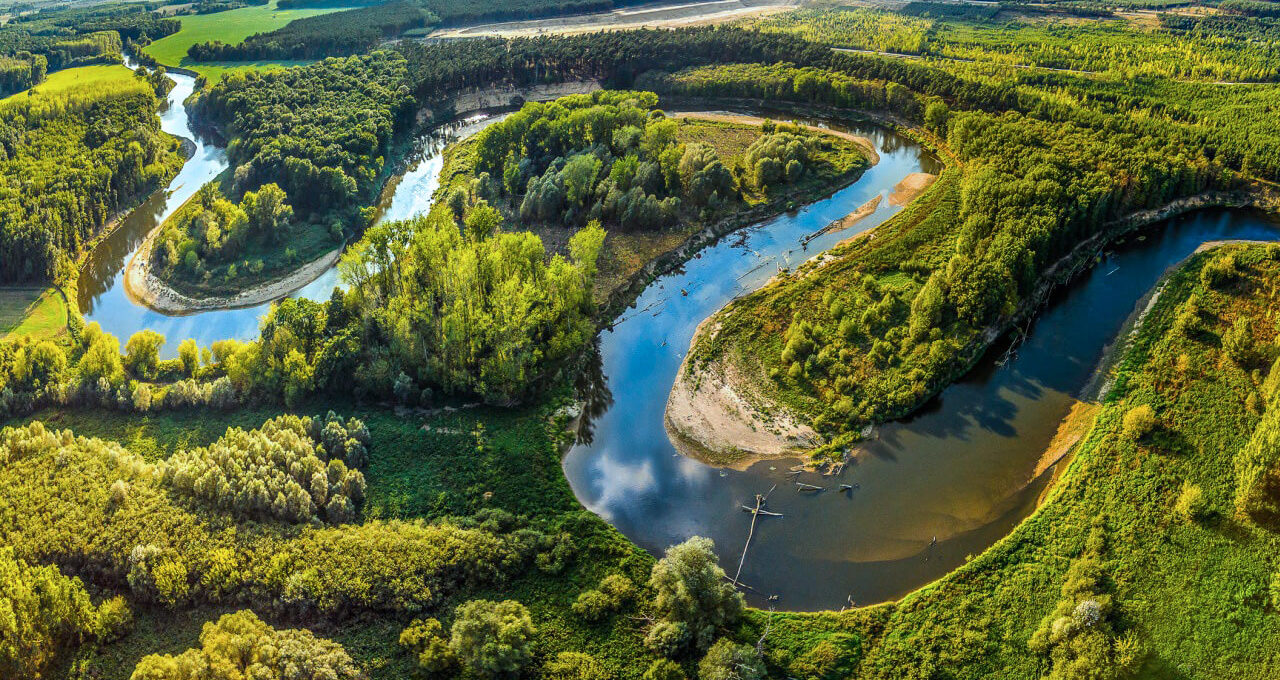












Оставить Комментарий